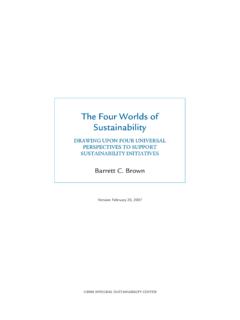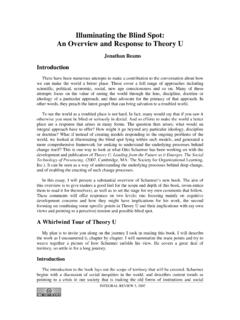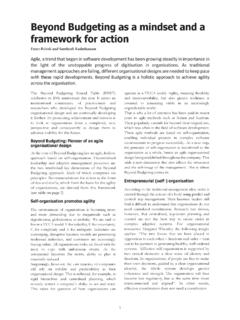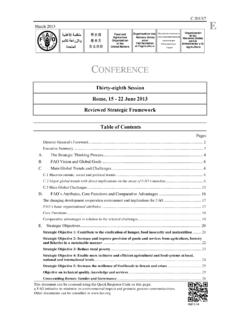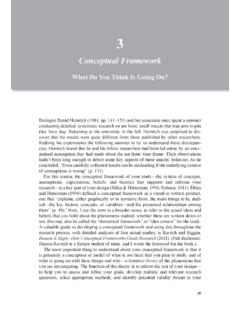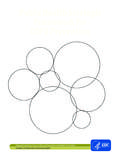Transcription of A DETAILED DESCRIPTION OF THE DEVELOPMENT …
1 Nine action Logics and Their DEVELOPMENT in Detail A DETAILED DESCRIPTION OF THE DEVELOPMENT OF NINE action LOGICS ADAPTED FROM EGO DEVELOPMENT THEORY1 FOR THE LEADERSHIP DEVELOPMENT framework 2002 Dr. Susanne R. Cook-Greuter Introduction The Leadership DEVELOPMENT framework is best understood as one of the several models that portray the different levels of DEVELOPMENT in the Upper Left Quadrant in Ken Wilber s All Quadrants, All Levels (AQAL) map of human experience. It describes the most common action logics found in today s professional world.
2 The table below shows that the LDF covers preconventional, conventional, postconventional and early post-postconventional ways of meaning making in Wilber s comprehensive model of consciousness. The schematic representation is meant to give you a sense of both the fine-tuned differentiations of the LDP and its overall fit within the larger model. Despite the appearance of this diagram, the theory is not to be seen as a simple hierarchy or linear progression or a stair-case. This is just one of the many ways this information can be represented and displayed.
3 K. Wilber % of US population Torbert action Logics Cook-Greuter Ego DEVELOPMENT Stages SOUL Transcendent Postpostconventional, Transpersonal, Ego-transcendent Unitive view <1% Ironist 6 Unitive <2% Magician 5/6 Construct-aware VISION LOGIC Postconventional Systems view ~12% Strategist Individualist 5 Autonomous 4/5 Individualist MIND Conventional ~75% Achiever Expert/technician Diplomat 4 Conscientious 3/4 Self-conscious 3 Conformist BODY Preconventional ~10% Opportunist Impulsive 2/3 ( ) Self-defensive 2 Impulsive Table 1.
4 The position of the LDF in Wilber s Model S. Cook-Greuter 2002 1 Nine action Logics and Their DEVELOPMENT in Detail Human DEVELOPMENT can be described in many ways although most theories see it as evolving in a spiral fashion, not lock step, with movement possible in all directions Up = Transformation, vertical DEVELOPMENT Horizontal expansion-transfer at same stage, (new skills more knowledge): Wilber calls this translating. Down = temporary or permanent regression Most growth in adults is of the horizontal, expansion kind.
5 People learn new skills, new methods, new facts, even new ways of organizing knowledge, but their current action logic or mental model of the world remains the same. The Leadership DEVELOPMENT framework , on the other hand, describes a sequence of how mental models themselves evolve over time. Each new level contains the previous ones as subsets. Each new level is both a new whole logic with its own coherence, and at the same time -- also a part of a larger, more complex meaning system. Moreover, the Leadership DEVELOPMENT framework describes a psycho-logical (sic) system with three interrelated components.
6 The operative component looks at what adults see as the purpose of life, what needs they act upon, and what ends they are moving towards. The affective component deals with emotions and the experience of being in this world. The cognitive component addresses the question of how a person thinks about him or herself and the world. It is important to understand that each action Logic emerges from a synthesis of doing, being and thinking despite the term logic, which may suggest an emphasis on cognition.
7 Metaphorically speaking, the Leadership DEVELOPMENT framework provides us with one possible account of how individuals navigate the straits of human existence by using navigational lore, common sense, increasingly complex maps, algorithms, and intuition. Function The LDF, a psycho-logy of human meaning making which addresses the following essential questions DOING * coping * needs and ends * purpose 1. Behavioral dimension How do people interact? What are the needs they act upon, and what ends do they try to achieve?
8 How do they cope and master their lives? What function do others play in an individual s life? BEING: * awareness * experience * affect 2. Affective dimension How do they feel about things? How do they deal with affect? What is the range of awareness and of their selective perception? How are events experienced and processed? What are the preferred defenses? THINKING * conceptions * knowledge * interpretation 3. Cognitive dimension How does a person think? How do individuals structure experience, how do they explain things, make sense of their experience?
9 What is the logic behind their perspectives on the self and the world? Table 2. Three dimensions of each action logic S. Cook-Greuter 2002 2 Nine action Logics and Their DEVELOPMENT in Detail 2002 Cook-Greuter3 KnowledgeNotice more pieces of puzzleDiscover patterns, rules and lawsPredict, measure and explainSee further ahead and back in time Know more and do moreIndividualistSocially programmedIncreasing DifferentiationConventional linear reasoningSelf/other-constructedIncreasin g integrationPostconventional understandingWisdomUnderstand more deeplyRecognize assumptionsSee whole dynamic systemSee within, around and beneathStrip away illusionsEmpty mind632 ImpulsiveOpportunisticDiplomatExpertAchi everStrategistMagicianAction Logics or Ego StagesIronist452/33/44/55/6 Figure 1.
10 Alternating stages of differentiation and integration Human DEVELOPMENT in general can be looked at as a progression of different ways of making sense of reality or different action logics. The action logics follow each other alternating between those that emphasize, on balance, differentiation over integration and those favoring integration over differentiation. This pattern of differentiation to integration can be observed both overall and from action logic to action logic. In the mid-sixties psychologists2 first postulated that human beings individuate by continuously renegotiating the balance between differentiation and integration.
